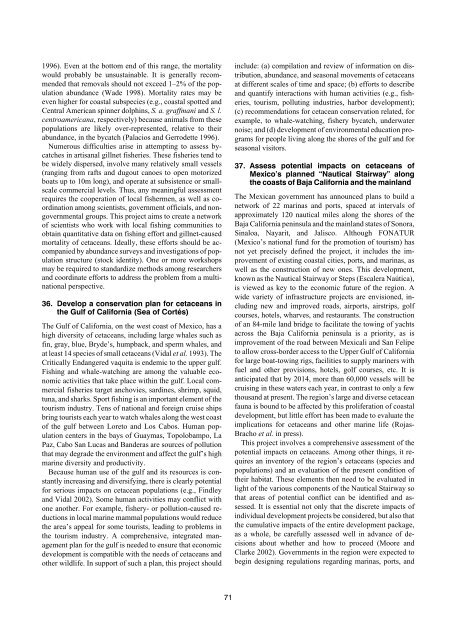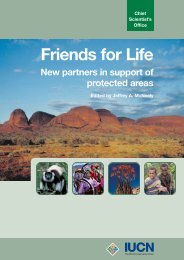Dolphins, Whales and Porpoises: 2002-2010 Conservation - IUCN
Dolphins, Whales and Porpoises: 2002-2010 Conservation - IUCN
Dolphins, Whales and Porpoises: 2002-2010 Conservation - IUCN
Create successful ePaper yourself
Turn your PDF publications into a flip-book with our unique Google optimized e-Paper software.
1996). Even at the bottom end of this range, the mortality<br />
would probably be unsustainable. It is generally recommended<br />
that removals should not exceed 1–2% of the population<br />
abundance (Wade 1998). Mortality rates may be<br />
even higher for coastal subspecies (e.g., coastal spotted <strong>and</strong><br />
Central American spinner dolphins, S. a. graffmani <strong>and</strong> S. l.<br />
centroamericana, respectively) because animals from these<br />
populations are likely over-represented, relative to their<br />
abundance, in the bycatch (Palacios <strong>and</strong> Gerrodette 1996).<br />
Numerous difficulties arise in attempting to assess bycatches<br />
in artisanal gillnet fisheries. These fisheries tend to<br />
be widely dispersed, involve many relatively small vessels<br />
(ranging from rafts <strong>and</strong> dugout canoes to open motorized<br />
boats up to 10m long), <strong>and</strong> operate at subsistence or smallscale<br />
commercial levels. Thus, any meaningful assessment<br />
requires the cooperation of local fishermen, as well as coordination<br />
among scientists, government officials, <strong>and</strong> nongovernmental<br />
groups. This project aims to create a network<br />
of scientists who work with local fishing communities to<br />
obtain quantitative data on fishing effort <strong>and</strong> gillnet-caused<br />
mortality of cetaceans. Ideally, these efforts should be accompanied<br />
by abundance surveys <strong>and</strong> investigations of population<br />
structure (stock identity). One or more workshops<br />
may be required to st<strong>and</strong>ardize methods among researchers<br />
<strong>and</strong> coordinate efforts to address the problem from a multinational<br />
perspective.<br />
36. Develop a conservation plan for cetaceans in<br />
the Gulf of California (Sea of Cortés)<br />
The Gulf of California, on the west coast of Mexico, has a<br />
high diversity of cetaceans, including large whales such as<br />
fin, gray, blue, Bryde’s, humpback, <strong>and</strong> sperm whales, <strong>and</strong><br />
at least 14 species of small cetaceans (Vidal et al. 1993). The<br />
Critically Endangered vaquita is endemic to the upper gulf.<br />
Fishing <strong>and</strong> whale-watching are among the valuable economic<br />
activities that take place within the gulf. Local commercial<br />
fisheries target anchovies, sardines, shrimp, squid,<br />
tuna, <strong>and</strong> sharks. Sport fishing is an important element of the<br />
tourism industry. Tens of national <strong>and</strong> foreign cruise ships<br />
bring tourists each year to watch whales along the west coast<br />
of the gulf between Loreto <strong>and</strong> Los Cabos. Human population<br />
centers in the bays of Guaymas, Topolobampo, La<br />
Paz, Cabo San Lucas <strong>and</strong> B<strong>and</strong>eras are sources of pollution<br />
that may degrade the environment <strong>and</strong> affect the gulf’s high<br />
marine diversity <strong>and</strong> productivity.<br />
Because human use of the gulf <strong>and</strong> its resources is constantly<br />
increasing <strong>and</strong> diversifying, there is clearly potential<br />
for serious impacts on cetacean populations (e.g., Findley<br />
<strong>and</strong> Vidal <strong>2002</strong>). Some human activities may conflict with<br />
one another. For example, fishery- or pollution-caused reductions<br />
in local marine mammal populations would reduce<br />
the area’s appeal for some tourists, leading to problems in<br />
the tourism industry. A comprehensive, integrated management<br />
plan for the gulf is needed to ensure that economic<br />
development is compatible with the needs of cetaceans <strong>and</strong><br />
other wildlife. In support of such a plan, this project should<br />
71<br />
include: (a) compilation <strong>and</strong> review of information on distribution,<br />
abundance, <strong>and</strong> seasonal movements of cetaceans<br />
at different scales of time <strong>and</strong> space; (b) efforts to describe<br />
<strong>and</strong> quantify interactions with human activities (e.g., fisheries,<br />
tourism, polluting industries, harbor development);<br />
(c) recommendations for cetacean conservation related, for<br />
example, to whale-watching, fishery bycatch, underwater<br />
noise; <strong>and</strong> (d) development of environmental education programs<br />
for people living along the shores of the gulf <strong>and</strong> for<br />
seasonal visitors.<br />
37. Assess potential impacts on cetaceans of<br />
Mexico’s planned “Nautical Stairway” along<br />
the coasts of Baja California <strong>and</strong> the mainl<strong>and</strong><br />
The Mexican government has announced plans to build a<br />
network of 22 marinas <strong>and</strong> ports, spaced at intervals of<br />
approximately 120 nautical miles along the shores of the<br />
Baja California peninsula <strong>and</strong> the mainl<strong>and</strong> states of Sonora,<br />
Sinaloa, Nayarit, <strong>and</strong> Jalisco. Although FONATUR<br />
(Mexico’s national fund for the promotion of tourism) has<br />
not yet precisely defined the project, it includes the improvement<br />
of existing coastal cities, ports, <strong>and</strong> marinas, as<br />
well as the construction of new ones. This development,<br />
known as the Nautical Stairway or Steps (Escalera Naútica),<br />
is viewed as key to the economic future of the region. A<br />
wide variety of infrastructure projects are envisioned, including<br />
new <strong>and</strong> improved roads, airports, airstrips, golf<br />
courses, hotels, wharves, <strong>and</strong> restaurants. The construction<br />
of an 84-mile l<strong>and</strong> bridge to facilitate the towing of yachts<br />
across the Baja California peninsula is a priority, as is<br />
improvement of the road between Mexicali <strong>and</strong> San Felipe<br />
to allow cross-border access to the Upper Gulf of California<br />
for large boat-towing rigs, facilities to supply mariners with<br />
fuel <strong>and</strong> other provisions, hotels, golf courses, etc. It is<br />
anticipated that by 2014, more than 60,000 vessels will be<br />
cruising in these waters each year, in contrast to only a few<br />
thous<strong>and</strong> at present. The region’s large <strong>and</strong> diverse cetacean<br />
fauna is bound to be affected by this proliferation of coastal<br />
development, but little effort has been made to evaluate the<br />
implications for cetaceans <strong>and</strong> other marine life (Rojas-<br />
Bracho et al. in press).<br />
This project involves a comprehensive assessment of the<br />
potential impacts on cetaceans. Among other things, it requires<br />
an inventory of the region’s cetaceans (species <strong>and</strong><br />
populations) <strong>and</strong> an evaluation of the present condition of<br />
their habitat. These elements then need to be evaluated in<br />
light of the various components of the Nautical Stairway so<br />
that areas of potential conflict can be identified <strong>and</strong> assessed.<br />
It is essential not only that the discrete impacts of<br />
individual development projects be considered, but also that<br />
the cumulative impacts of the entire development package,<br />
as a whole, be carefully assessed well in advance of decisions<br />
about whether <strong>and</strong> how to proceed (Moore <strong>and</strong><br />
Clarke <strong>2002</strong>). Governments in the region were expected to<br />
begin designing regulations regarding marinas, ports, <strong>and</strong>






